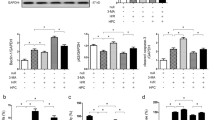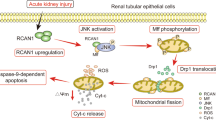Abstract
Purpose
The majority of renal ischemic/reperfusion (I/R) and ischemic postconditioning (IPO) studies have been based on animal models. To gain mechanistic insights into ischemic postconditioning-induced alterations at the cell level, a novel in vitro model of I/R and IPO is set up by using the rat proximal tubule cell line NRK-52E.
Methods
Cells are incubated in 1 mL ischemic buffer under hypoxia conditions for 3 h to simulate the clinical condition of a cellular microenvironment representative of ischemia, including oxygen deprivation, carbon dioxide elevation, nutrient depletion, and waste accumulation. IPO model is established by exposing the cells to three cycles of ‘mimic reperfusion condition’ for 10 min and ischemic condition for 10 min after placing the cells in ischemic condition for 3 h. Flow cytometry and Hoechst are used to assessing apoptosis. The expression spot and protein levels of PDK, Akt, and ERK are also analyzed.
Results
I/R results in severe injury in NRK-52E cells as evidenced by increased LDH leakage in the culture medium, as well as increased apoptotic index, which may be significantly attenuated by IPO treatment applied before the abrupt reperfusion (P < 0.05 vs. I/R group). Meanwhile, IPO, compared with I/R, increases phosphorylation levels of Akt and ERK (P < 0.05 vs. I/R group), which have been identified to play a vital role in the regulation of cell proliferation, survival, and metabolism.
Conclusion
A new in vitro model of I/R and IPO is established successfully. These results offer evidence that 3 h of simulating ischemic/reperfusion injury may cause cell apoptosis, and IPO is effective to attenuate renal cell apoptosis and potentially mediate via activation of Akt and ERK signal.






Similar content being viewed by others
References
Martins PN, Chandraker A, Tullius SG (2006) Modifying graft immunogenicity and immune response prior to transplantation: potential clinical applications of donor and graft treatment. Transpl Int 19:351–359
Sehirli O, Sener E, Cetinel S, Yüksel M, Gedik N, Sener G (2008) Alpha-lipoic acid protects against renal ischaemia-reperfusion injury in rats. Clin Exp Pharmacol Physiol 35:249–255
Zager RA, Iwata M, Burkhart KM, Schimpf BA (1994) Post-ischemic acute renal failure protects proximal tubules from O2 deprivation injury, possibly by inducing uremia. Kidney Int 45:1760–1768
Park KM, Chen A, Bonventre JV (1999) Prevention of kidney ischemia/reperfusion-induced functional injury and JNK, p38, and MAPK kinase activation by remote ischemic pretreatment. J Biol Chem 276:11870–11876
Toosy N, McMorris EL, Grace PA (1999) Ischemic preconditioning protects the rat kidney from reperfusion injury. BJU Int 84:489–494
Jefayri MK, Grace PA, Mathie RT (2000) Attenuation of reperfusion injury by renal ischemic preconditioning: the role of nitric oxide. BJU Int 85:1007–1013
Lee HT, Emala CW (2001) Protein kinase C and Gi/o proteins are involved in adenosine and ischemic preconditioning-mediated renal protection. J Am Soc Nephrol 12:233–240
Torras J, Herrero-Fresneda I, Lloberas N, Riera M, Ma Cruzado J, Ma Grinyó J (2002) Promising effects of ischemic preconditioning in renal transplantation. Kidney In 61:2218–2227
Zhao ZQ, Vinten-Johansen J (2006) Postconditioning: reduction of reperfusion-induced injury. Cardiovasc Res 70:200–211
Liu X, Chen H, Zhan B, Xing B, Zhou J, Zhu H, Chen Z (2007) Attenuation of reperfusion injury by renal ischemic postconditioning: the role of NO. Biochem Biophys Res Commun 359:628–634
Chen H, Xing B, Liu X, Zhan B, Zhou J, Zhu H, Chen Z (2008) Ischemic post- conditioning inhibits apoptosis after renal ischemia/reperfusion injury in rat. Transpl Int 21:364–371
Toback FG (1992) Regeneration after acute tubular necrosis. Kidney Int 41:226–246
Safirstein R, DiMari J, Megyesi J, Price P (1998) Mechanisms of renal repair and survival following acute injury. Semin Nephrol 18:519–522
Aikawa R, Nawano M, Gu Y, Katagiri H, Asano T, Zhu W, Nagai R, Komuro I (2000) Insulin prevents cardiomyocytes from oxidative stress-induced apoptosis through activation of PI3 Kinase/Akt. Circulation 102:2873–2879
Steelman LS, Stadelman KM, Chappell WH, Horn S, Bäsecke J, Cervello M, Nicoletti F, Libra M, Stivala F, Martelli AM, McCubrey JA (2008) Akt as a therapeutic target in cancer. Expert Opin Ther Targets 12:1139–1165
Matsui T, Tao J, del Monte F, Lee KH, Li L, Picard M, Force TL, Franke TF, Hajjar RJ, Rosenzweig A (2001) Akt activation preserves cardiac function and prevents injury after transient cardiac ischemia in vivo. Circulation 104:330–335
Tsang A, Hausenloy DJ, Mocanu MM, Yellon DM (2004) Postconditioning: a form of ‘‘modified reperfusion’’ protects the myocardium by activating the phosphatidylinositol 3-kinase-akt pathway. Circ Res 95:230–232
Galatou E, Carnická S, Nemčeková M, Ledvényiová V, Adameová A, Kelly T, Barlaka E, Galatou E, Khandelwal VK, Lazou A (2012) PPAR-alpha activation as a preconditioning-like intervention in rats in vivo confers myocardial protection against acute ischaemia-reperfusion injury: involvement of PI3 K-Akt. Can J Physiol Pharmacol 90:1135–1144
Shibata M, Yamawaki T, Sasaki T, Hattori H, Hamada J, Fukuuchi Y, Okano H, Miura M (2002) Upregulation of Akt phosphorylation at the early stage of middle cerebral artery occlusion in mice. Brain Res 942:1–10
Harada N, Hatano E, Koizumi N, Nitta T, Yoshida M, Yamamoto N, Brenner DA, Yamaoka Y (2004) Akt activation protects rat liver from ischemia/reperfusion injury. J Surg Res 121:159–170
Toledo-Pereyra LH, Lopez-Neblina F, Reuben JS, Toledo AH, Ward PA (2004) Selectin inhibition modulates Akt/MAPK signaling and chemokine expression after liver ischemia–reperfusion. J Invest Surg 17:303–313
Sano T, Izuishi K, Hossain MA, Kakinoki K, Okano K, Masaki T, Suzuki Y (2010) Protective effect of lipopolysaccharide preconditioning in hepatic ischemia reperfusion injury. HPB (Oxford) 12:538–545
Park KM, Chen A, Bonventre JV (2001) Prevention of kidney ischemia/reperfusion-induced functional injury and JNK, p38, and MAPK kinase activation by remote ischemic pretreatment. J Biol Chem 276:11870–11876
Park KM, Kramers C, Vayssier-Taussat M, Chen A, Bonventre JV (2002) Prevention of kidney ischemia/reperfusion-induced functional injury, MAPK and MAPK kinase activation, and inflammation by remote transient ureteral obstruction. J Biol Chem 277:2040–2049
Sauvant C, Schneider R, Holzinger H, Renker S, Wanner C, Gekle M (2009) Implementation of an in vitro model system for investigation of reperfusion damage after renal ischemia. Cell Physiol Biochem 24:567–576
Meldrum KK, Meldrum DR, Hile KL, Burnett AL, Harken AH (2001) A novel model of ischemia in renal tubular cells which closely parallels in vivo injury. J Surg Res 99:288–293
Pitts KR, Toomb CF (2004) Coverslip hypoxia: a novel method for studying cardiac myocyte hypoxia and ischemia in vitro. Am J Physiol Heart Circ Physiol 287:H1801–H1812
Cavdar Z, Oktay G, Egrilmez MY, Genc S, Genc K, Altun Z, Islekel H, Guner G (2010) In vitro reoxygenation following hypoxia increases MMP-2 and TIMP-2 secretion by human umbilical vein endothelial cells. Acta Biochim Pol 57:69–73
Saenz-Morales D, Escribese MM, Stamatakis K, García-Martos M, Alegre L, Conde E, Pérez-Sala D, Mampaso F, García-Bermejo ML (2006) Requirements for proximal tubule epithelial cell detachment in response to ischemia: role of oxidative stress. Exp Cell Res 312:3711–3727
Saenz-Morales D, Conde E, Escribese MM, García-Martos M, Alegre L, Blanco-Sánchez I, García-Bermejo ML (2009) ERK1/2 mediates cytoskeleton and focal adhesion impairment in proximal epithelial cells after renal ischemia. Cell Physiol Biochem 23:285–294
Basnakian AG, Ueda N, Hong X, Galitovsky VE, Yin X, Shah SV (2005) Ceramide synthase is essential for endonuclease-mediated death of renal tubular epithelial cells induced by hypoxia-reoxygenation. Am J Physiol Renal Physiol 288:F308–F314
Leichtweiss HP, Lübbers DW, Weiss C, Baumgärtl H, Reschke W (1969) The oxygen supply of the rat kidney: measurements of int4arenal pO2. Pflugers Arch 309:328–349
Holloway JC, Phifer T, Henderson R, Welbourne TC (1986) Renal acid-base metabolism after ischemia. Kidney Int 29:989–994
Bonegio R, Lieberthal W (2002) Role of apoptosis in the pathogenesis of acute renal failure. Curr Opin Nephrol Hypertens 11:301–308
Padanilam BJ (2003) Cell death induced by acute renal injury: a perspective on the contributions of apoptosis and necrosis. Am J Physiol Renal Physiol 284:F608–F627
Acknowledgments
This work was supported by the National Natural Science Foundation of China (Nos. 30901494 and 30901552), the Hubei Province Natural Science Foundation (No. 2012FFA096), and supported by “the Fundamental Research Funds for the Central Universities (No. 302-274231)”.
Conflict of interest
None.
Author information
Authors and Affiliations
Corresponding author
Additional information
Xiaodong Weng and Min Wang have contributed equally to this work and are co-first authors.
Rights and permissions
About this article
Cite this article
Weng, X., Wang, M., Chen, H. et al. Ischemic postconditioning inhibits apoptosis of renal cells following reperfusion: a novel in vitro model. Int Urol Nephrol 47, 1067–1074 (2015). https://doi.org/10.1007/s11255-015-0997-x
Received:
Accepted:
Published:
Issue Date:
DOI: https://doi.org/10.1007/s11255-015-0997-x




